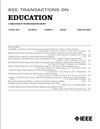IC-BTCN: A Deep Learning Model for Dropout Prediction of MOOCs Students
IF 2
2区 工程技术
Q2 EDUCATION, SCIENTIFIC DISCIPLINES
引用次数: 0
Abstract
Contribution: This study proposes a student dropout prediction model, named image convolutional and bi-directional temporal convolutional network (IC-BTCN), which makes dropout prediction for learners based on the learning clickstream data of students in massive open online courses (MOOCs) courses. Background: The MOOCs learning platform attracts hundreds of millions of users with in-depth teaching content and low-threshold learning methods. However, the high-dropout rate has always been its weakness compared with offline teaching. Intended Outcomes: The effectiveness of IC-BTCN model is evaluated on the KDD CUP 2015 dataset, including a large amount of clickstream data from the online learning platforms. The experimental results show that IC-BTCN model achieves an accuracy rate of 89.3%. Application Design: First, learning record data of students are converted into 3-D learning behavior matrix. Then, local features of the behavior matrix are extracted through convolutional techniques. These extracted learning features are then input into a temporal convolutional network to further refine the data. The temporal learning features of students are extracted through dilated causal convolution. Finally, a multilayer perceptron is used to derive the dropout prediction for students. Findings: Compared with three typical deep learning models, IC-BTCN model is advanced in accuracy and other evaluation indicators. On the premise of complying with the provisions of MOOCs platforms, the IC-BTCN model has good portability and practicability.IC-BTCN:用于预测 MOOCs 学生辍学情况的深度学习模型
贡献:本研究提出了一种学生辍学预测模型,命名为图像卷积和双向时间卷积网络(IC-BTCN),该模型基于大规模在线开放课程(mooc)中学生的学习点击流数据对学习者进行辍学预测。背景:mooc学习平台以深度的教学内容和低门槛的学习方式吸引了上亿用户。然而,与线下教学相比,高辍学率一直是其弱点。预期结果:IC-BTCN模型的有效性在KDD CUP 2015数据集上进行了评估,其中包括来自在线学习平台的大量点击流数据。实验结果表明,IC-BTCN模型的准确率达到89.3%。应用设计:首先,将学生的学习记录数据转换成三维学习行为矩阵。然后,通过卷积技术提取行为矩阵的局部特征;然后将这些提取的学习特征输入到时间卷积网络中以进一步优化数据。通过扩展因果卷积提取学生的时间学习特征。最后,使用多层感知器对学生进行退学预测。结果:与三种典型的深度学习模型相比,IC-BTCN模型在准确率等评价指标上具有优势。在符合mooc平台规定的前提下,IC-BTCN模型具有良好的可移植性和实用性。
本文章由计算机程序翻译,如有差异,请以英文原文为准。
求助全文
约1分钟内获得全文
求助全文
来源期刊

IEEE Transactions on Education
工程技术-工程:电子与电气
CiteScore
5.80
自引率
7.70%
发文量
90
审稿时长
1 months
期刊介绍:
The IEEE Transactions on Education (ToE) publishes significant and original scholarly contributions to education in electrical and electronics engineering, computer engineering, computer science, and other fields within the scope of interest of IEEE. Contributions must address discovery, integration, and/or application of knowledge in education in these fields. Articles must support contributions and assertions with compelling evidence and provide explicit, transparent descriptions of the processes through which the evidence is collected, analyzed, and interpreted. While characteristics of compelling evidence cannot be described to address every conceivable situation, generally assessment of the work being reported must go beyond student self-report and attitudinal data.
 求助内容:
求助内容: 应助结果提醒方式:
应助结果提醒方式:


